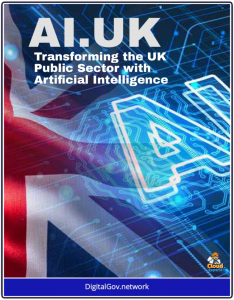Home Office 2030 Digital Strategy – A Leader in AI-Powered Digital Innovation
The strategy emphasizes AI and automation to modernize and optimize critical processes, making them faster, more accurate, and less resource-intensive.
 The Home Office 2030 Digital Strategy sets out an ambitious five-year vision to transform the UK Home Office’s use of digital, data, and technology to deliver better public services, strengthen border security, enhance policing, and bolster national security.
The Home Office 2030 Digital Strategy sets out an ambitious five-year vision to transform the UK Home Office’s use of digital, data, and technology to deliver better public services, strengthen border security, enhance policing, and bolster national security.
Building on achievements like passport renewals in under 48 hours and 76 million annual eGate crossings, the strategy aims to position the Home Office as a leader in digital innovation within the UK government.
It emphasizes transparency, cross-government collaboration, and a focus on measurable outcomes to ensure safer, more efficient services while maintaining public trust and security.
The strategy focuses on transforming services through the adoption of artificial intelligence and automation to streamline critical processes, such as border checks and policing operations, including the use of Automated Number Plate Recognition.
Home Office teams are at different levels of digital transformation with AI and automation, but our ambition by 2030 is to bring automation to as many of our business areas as possible. Our approach will carefully balance the benefits and risks of AI and automation to add value to our work and better support the people we serve.
It prioritizes the development of maintainable, sustainable digital systems that can be continuously improved to meet future demands. To enhance organizational agility and resilience, the Home Office will adopt a product-based operating model, enabling rapid responses to evolving needs and challenges.
Recognizing the growing threat of cyberattacks, the strategy commits to strengthening cybersecurity capabilities to protect critical systems and data. It also emphasizes improving data capture and sharing by creating secure, reusable data sources to reduce redundancy and support better decision-making across government departments. Additionally, the Home Office will evolve its digital operating model to align technology with its core objectives, ensuring services are designed to deliver tangible outcomes.
To support this transformation, the strategy highlights the importance of upskilling civil servants to enhance their digital capabilities, equipping them to drive and sustain change. At its core, the strategy adopts a user-centric approach, designing services based on the needs of citizens and rigorously testing for accessibility to ensure inclusivity.
Building on the foundations of the 2024 Digital, Data, and Technology Strategy, the Home Office 2030 Digital Strategy aims to establish the department as a global leader in digital government by 2030.
AI Strategy
The strategy emphasizes AI and automation to modernize and optimize critical processes, making them faster, more accurate, and less resource-intensive. AI is leveraged to handle large-scale data processing, improve decision-making, and enhance user experiences while maintaining security and public trust.
The document specifically notes the use of AI in areas like border management and policing, with ANPR as a key example. Below are the primary AI applications outlined or implied in the strategy:
Streamlining Border Management
AI is applied to enhance border security processes, such as those at eGates, which facilitate 76 million crossings annually. AI-powered systems can analyze traveler data in real-time, using biometric technologies (e.g., facial recognition) to verify identities quickly and accurately. This reduces wait times, improves security by flagging potential risks, and automates routine checks, allowing border officials to focus on complex cases. The strategy aims to further integrate AI to make border processes seamless while maintaining robust security standards.
Enhancing Policing with Automated Number Plate Recognition (ANPR)
ANPR is a prominent example of AI application in policing. This technology uses AI-driven image recognition to scan vehicle license plates in real-time, cross-referencing them against databases to identify vehicles linked to criminal activity, stolen cars, or other alerts. ANPR systems rely on machine learning algorithms to process vast amounts of visual data quickly, enabling law enforcement to respond proactively to threats. The strategy highlights ANPR as part of its broader goal to use AI to support policing by automating repetitive tasks, freeing up officers for higher-priority duties.
Improving Decision-Making with Data Analytics
AI is used to analyze large datasets to identify patterns, predict trends, and support decision-making across Home Office functions. For example, in national security, AI can process intelligence data to detect potential threats or anomalies, enabling faster responses. In public services, AI-driven analytics can optimize resource allocation, such as predicting demand for passport services or identifying fraud in immigration applications. The strategy’s focus on reusable, secure data sources underscores AI’s role in making data-driven decisions more efficient and reliable.
Automating Routine Processes
AI is deployed to automate repetitive tasks across Home Office operations, reducing manual workloads and improving efficiency. For instance, in passport processing (already reduced to under 48 hours for renewals), AI can automate document verification, detect errors in applications, or prioritize urgent cases. Similarly, in customer-facing services, AI-powered chatbots or virtual assistants can handle routine inquiries, allowing staff to focus on complex issues. This aligns with the strategy’s goal of transforming services to be more user-centric and efficient.
Strengthening Cybersecurity
While not explicitly detailed, the strategy’s focus on cybersecurity implies AI’s role in detecting and responding to cyber threats. AI can monitor network activity, identify suspicious patterns (e.g., unusual login attempts), and predict potential vulnerabilities in real-time. By automating threat detection, AI enhances the Home Office’s ability to protect sensitive data and critical infrastructure, a key priority given the growing sophistication of cyberattacks.
Broader Implications and Approach
The strategy emphasizes that AI applications are designed with a user-centric focus, ensuring services are accessible and meet public needs. AI systems are rigorously tested for fairness, accuracy, and inclusivity to maintain public trust.
The Home Office also aims to integrate AI within sustainable, maintainable digital platforms, ensuring long-term scalability. By combining AI with improved data-sharing and staff upskilling, the strategy seeks to create a cohesive ecosystem where AI enhances human capabilities rather than replacing them.
In summary, the Home Office 2030 Digital Strategy positions AI as a transformative tool to streamline processes, enhance security, and improve service delivery. From ANPR in policing to biometric checks at borders and automated administrative tasks, AI applications are central to achieving the strategy’s vision of a digitally advanced, efficient, and secure Home Office by 2030.




